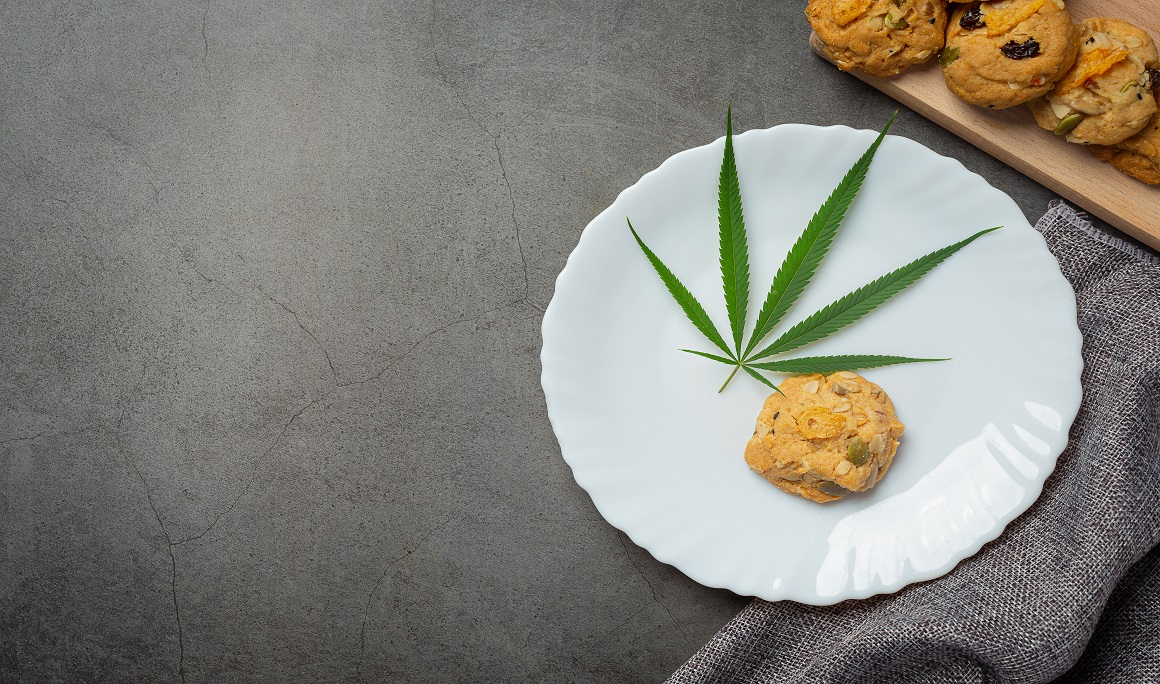If you’re unfamiliar with cannabis culture beyond a superficial understanding of what it is. There are many preparations of THC that go beyond the cannabis “flower”. Hash is one such preparation.

cannabis cookie and cannabis leaf put on white plate
Hashish is a well-known compound among those familiar with cannabis culture. Also known as hash, hasheesh, and haschich, this compound is a concentrated, highly-intoxicating form of cannabis resin. It is derived from the cannabis plant and can be prepared organically or with advanced chemicals and technologies.
Hashish is generally higher in THC content that unprocessed marijuana buds. The compound is also more compact. So, a small of the substance can deliver a more potent effect than a similar amount of cannabis bud.
Hashish will also retain is potency for longer than cannabis buds. This is due to the compression of traditional hashish experiences during its processing. Hashish is generally pressed into bricks, blocks or discs. The surface of the compound will be exposed to light and oxidize. This causes compounds to degrade and lose potency over time. In the case of hashish, the protected inner material will be less affected.
The labor to create hashish is considerably more involved than with general marijuana cultivation. This drives up the price and scarcity of hashish in many regions. Hashish is predominantly prepared in Asia and consumed in Eurasia.
In the production of hashish, cannabis plants are selected for stout stature and highly resinous characteristics.
Hashish will generally have a THC content of 5 percent to 25 percent. THC concentrations upwards of 45 percent have also been reported.
If you are just learning about hashish, you may be asking yourself why people began and continue to use it. Well, the answer resides in the same reasoning for more pungent perfumes, higher ABV alcohol products, and any other example where you can identify variations in potency. The variety and the ability to utilize more or less of a substance relative to its application.
Hashish is also relatively pure. Cannabis is often subject to more exposure, requires more delicacy in harvesting before going market, and is more heavily reliant on proper curing for a pleasant user experience.
There are many methods growers and processors use to produce hashish.
These methods range from very traditional, labor-intensive practices to those that require the aid of chemicals or machinery. The two latter examples have gained prominence due to their relative ease and speed. However, many consumers prefer their hashish to be produced with as few chemical processes as possible to retain the purity and flavor of their hashish.
One of the most enduring traditional methods of hashish production is a labor-intensive practice utilizing the harvesters’ hands or leather garments designed to capture cannabis resin in the fields to then later be scraped off with dull knives. As the workers would move through fields in their leather aprons, cannabis resin would adhere to and collect on their garments. At the end of the day, the resin-covered aprons would be scraped and the material compressed into hashish.
Other low-tech methods for creating hashish involve filtering cannabis plant material through a series of extra fine fabric screens. Fabric screens tend to be made of silk which metal screens will be steel, aluminum or brass.
In the case of screen filtration production processes, the cannabis plant matter must be thoroughly dried before the process may begin. This can be done cheaply and efficiently in arid climates. However, more humid regions may require cannabis to be dried through an artificial heating process.
After the resinous material has been refined, it may undergo further processing. This can include heating, rolling, and compression. The result is a hardened, sticky mass that can be easily separated for sale or distribution.
The resulting product’s color will indicate the level of purity. Glossy to dull brown hashish is considered pure, while hashish with more green hues will indicate an abundance of unwanted plant matter. Unscrupulous producers may add oils and bulking agents to increase overall yields.
Hand-prepared hashish is not unlike the apron method detailed above. In this case, harvesters will run their hands along the surface of resinous buds throughout cannabis fields. The sticky resin glands and secretions of the cannabis plant adhere to the palms, which are then rubbed into a concentrated mass and scraped from the skin to be further processed. This method is considered the most labor-intensive and has largely been abandoned in favor of more modern hashish production methods.
Hashish production using solvents is a relatively low-labor method of extraction and processing. However, the process can be volatile and dangerous when the proper safety precautions are not adopted. Fires and explosions can easily result in loss of life and loss of material.
Hashish processed with solvents can range in consistency from liquid or oil, viscous and sludge-like, or dense masses. This is dependent on the extent of distillation used. These examples are generally identified using terms like hash oil, butane hash, liquid hashish, honey oil, wax, dabs, shatter, nug runs, and budder. These examples of hashish generally contain a THC concentration ranging from 20 percent to 50 percent. Though, levels of 60% and higher have been reported.
While solvents (predominantly alcohol in the case of hashish) are generally thought of as having a negative connotation, the medical cannabis industry relies heavily on these methods. These cannabinoids and cannabis substances are refined considerably and are most often promoted in the form of tinctures, tablets, and sprays.
Final Thoughts on Hashish
Now you know what hashish is, how hashish is produced, and how hashish is most often utilized.
You can decide for yourself whether it is a subject worthy of further study.
If you care to move forward with your search for the best hashish and cannabis concentrates, we have plenty of recommendations for you.
All our recommended hashish strains, producers, and sources give you the details you need to find the right products at the right price, and produced in line with your preferences.